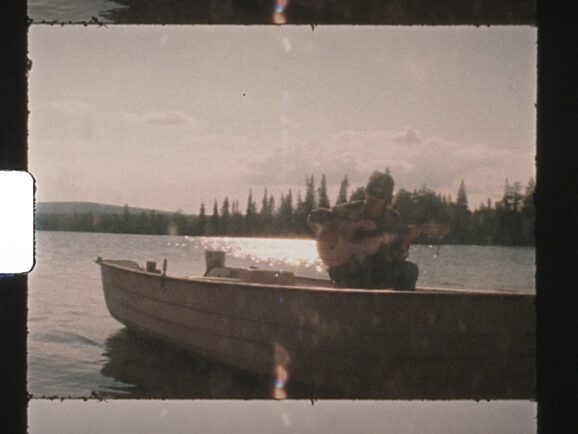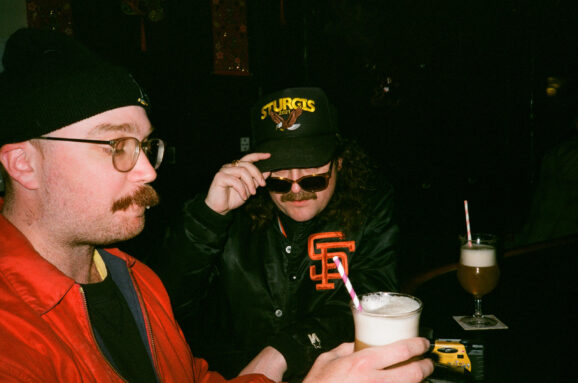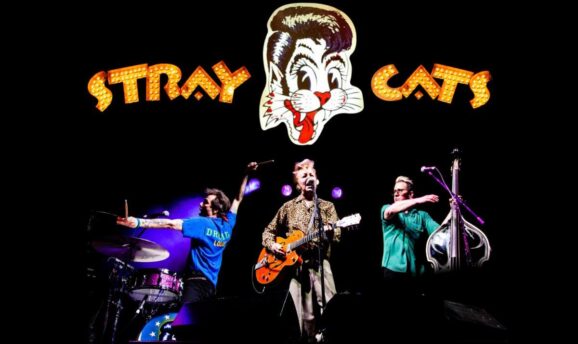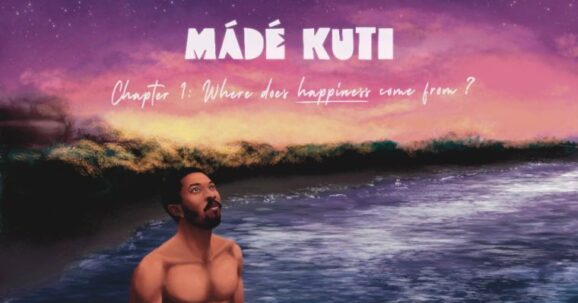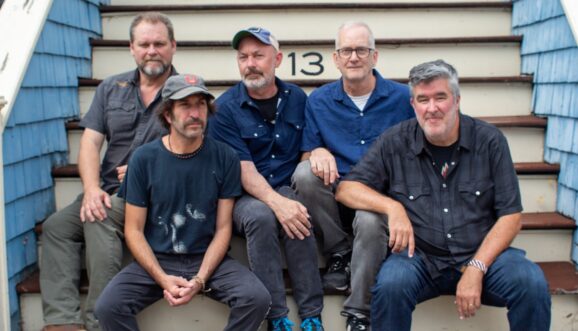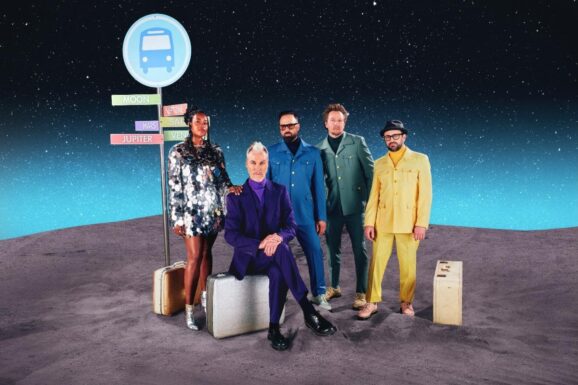This summer, The Lumineers’ co-founder Jeremiah Fraites and ambient artist Taylor Deupree released Northern (Redux) via Dualtone Records/Mercury KX, a newly interpreted version of Deupree’s 2006 album, Northern. The project is unique both in its conception and in its outcome since both artists found an organic working method to evolve tracks after passing on the idea of Fraites simply doing piano renderings of the songs on Northern. Having released his solo album Piano Piano in 2021, Fraites had recently been thinking of experimental possibilities for sound and Production, which put him in an adventurous mindset for Northern (Redux).
Fraites and Deupree corresponded long-distance over a considerable period of time on these tracks, developing a large body of creative material to sift through before combining elements to create these new versions in a sculpture-like process. Fraites had long been a fan of Deupree’s work, and in particular had been impacted by Northern, so found himself easily playing piano alongside those tracks rather than along with them. That led to all kinds of discoveries for Fraites, and in turn, Deupree discovered new possibilities for further development. I spoke with Jeremiah Fraites about this unconventional approach to bringing new “storytelling” to existing music and why, as a musician, he found it particularly inspiring.
Hannah Means-Shannon: I can see a lot of reasons for you and Taylor Deupree to collaborate, but I’m wondering out of his work, why the Northern album was chosen as the focus at this time. Presumably it could have been other things.
Jeremiah Fraites: [Laughs] Yeah, it could always be something else. I feel like I’ve been very busy in a good way. It’s been a wild ride with The Lumineers, really for the last ten years of my life. It’s a question that goes into the life of a full-time musician. What do you work on and why do you work on those things? I’m 37, and I think as I age, I’m coming to realize that I’d rather work on things that I care about, things that I’d die for, as dramatic as that may sound. More humans should try to do that. This Taylor Deupree collaboration was certainly one of those things. He actually reached out to me about it.
When the album Northern came out, in 2006, another good buddy of mine, Joseph Branciforte, turned me onto that album back when I was living in New Jersey. I thought, “Wow, this is really cool!” It really turned my mind on to the possibilities of instrumental music. It was so sparse and simple, yet so evocative and emotional. I really fell in love with the record. I think I e-mailed Taylor at some point, and we kind of kept loosely in touch. He e-mailed me, somewhat out of the blue, saying that Northern was coming up on an anniversary and he asked if I wanted to do something like piano versions of the songs on the album. Because he had heard my Piano Piano album, my solo project.
When he reached out to me, I started playing the album on Spotify next to my grand piano in Denver, Colorado. I immediately started playing piano against the original recordings, but after 30 seconds, I stopped, thinking, “Wow, this is really cool. This is really fun, actually.” It was inspiring. I got back to him saying that it would be great and giving my suggestions, but then I didn’t really hear from him for a couple of months. I thought, “Wow, I got ghosted!” Then he hit me up again, and we realized he never got my response. It must have gone into spam or junk mail somehow, so the project almost never happened.
But then he said, “Yes, let’s do it!” I had said, “I have an idea to present to you. Instead of me taking a stab at Northern and presenting piano covers of the music, which I think would be tough with this music, what if we did a collaboration? What if I wrote new piano pieces to and against your original tracks?” He really loved the idea and when I sent him some stuff, he said that he got goosebumps from hearing it. That’s kind of how we worked. We never actually met to work on the album. I was either working in Denver, or on the road. I worked on it a little bit in India, Australia, Los Angeles, Canada, and I was just chipping away at it. I’m really proud of it.
HMS: Would Taylor then come back to you with another layer of additions once he heard your first contributions to a track?
JF: Exactly. And when you collaborate with someone, that is the coolest moment. You send someone something that you think is either incredible or you think it’s good enough to send, and then they send you something back that’s way better, piggy-backing off what you sent. That’s why I love working in music, that high, that moment of discovery. It’s so divine.
We used a program called “Audio Movers”, which enabled us to hear what the other person was working on with almost no latency. I think I got the tracks from him the way that you hear them on the release, then I played them in Pro Tools, then I performed on a piano against that, and I would do a full take. For those who aren’t familiar with the album Northern, the songs at minimum are six minutes long, and some of them are nine or ten minutes, so it was really meditative. It was really something different than I’d ever done, trying out these shapes and different chords. I’d do a full pass, and I’d pick up on things. Maybe we’d do two or three full takes, then maybe we’d focus in on a particular section.
What was really nice about this project was that I was able to dump a lot of creative ideas, a lot of raw piano, and then sift through it. Taylor would then sift through all these pieces for the songs, and he’d sometimes change the time-line of when I played them. He’d manipulate some of the pianos to make them sound more out-there, which was really cool. I’d get all the stems, change things, and send it back. We’d meet in the middle and finish songs that way. That’s how the album came to be.
HMS: My reaction, as someone who’s often an editor, is that I’d be terrified of losing track of things with that approach. Did you work on one song at a time to try to make it simpler, or did you just welcome the chaos?
JF: We started out with good intentions. It got a little chaotic at times. Sometimes he’d send me something that was V3 (version 3) and I’d think, “I want this one part from V2! And also, you did something on V7 that was phenomenal!” But thankfully we never lost anything or undid anything that couldn’t be redone. We avoided tragedies along the way. [Laughs] The cool thing was, we could also both tell when we were on to something. We could just feel when something was happening.
For me, as someone who makes instrumental music, and listens to instrumental music, you can tell when something’s happening. You can tell when a story is being told even without words and traditional storytelling. I think you can tell when something’s just meandering, too, and it’s not actually doing anything. There’s that fine line between, “This is boring as fuck.”, and me having full-body goosebumps! It’s almost scary how fine of a line that is. Finding the difference between the two is everything about working on music.
Something else that was unique about this project is that we afforded ourselves time to work on it and I don’t think that we allowed ourselves to get burned out on it. Taylor had worked on this album many years ago and I think that he was so used to the music, too. It would be similar if me and my partner Wes in the Lumineers were to work on a Lumineers track. We’ve heard our own music so much that we might be almost blind to certain things about it. But I think for this Taylor project, I was able to come in with a fresh look and a fresh set of legs, and say, “This is really working!” Sometimes when you’ve worked on something so much, it’s hard to tell, and you need to show it to someone else.
HMS: I’m very interested by what mentioned about storytelling. When I talk to people about instrumental music, I try not to force the idea of storytelling on them, since sometimes that’s not their particular goal. I did feel like there was an aspect of storytelling to these new tracks. Was their an original “story” you were trying to follow and build on from the first versions, or do you feel that you started carte blanche?
JF: Track one on the Northern album, “Everything’s Gone Grey”, had an intrinsic beat to it. On Taylor’s original song, it had a kick-drum tempo. That made it cool. Another song, track five, “Haze It May Be”, did not have an intrinsic rhythm to it. The self-titled song “Northern” didn’t have one, either. On those last two, I kind of super-imposed rhythms where there weren’t any. As I was playing them, I thought, “I feel like there’s a rhythm in there intrinsically.”
For “Haze It May Be”, Taylor actually took all of his stems and made a beat out of them. It’s this really cool, slow pulse that’s hypnotic. When he sent this to me, I thought it changed the whole song. It became my favorite song and it still is. I created some extra work for us by writing some rhythm into that song “Northern” since I felt like I could hear it in there somewhere. It could be troublesome at times because if you moved the beat even 0.2 second over, it would get out of alignment. We never used clicks, but ultimately I think we got it to really work.
That was almost like teasing out elements that I felt were already there on the tracks. Then, at other times, I felt like we could create canyon-like sad moments that weren’t there on the original records. It depended on the track-by-track approach. We could also see more clearly as we edited things down more and more, what was working and what was not working.
There was one song where I’d recorded a bunch of piano, he’d sent me back his ideas, and I felt like it wasn’t working at all because of the piano. It was a ten-minute song, “Shell Shell Bye.” It wasn’t working for me, so I re-recorded all the piano right on the spot. I changed all the chord and rewrote it right on the spot. Then I thought, “Ah. This is it. This is the song.” I sent it back to Taylor, and he agreed. When you feel like you find something in art that is objective, that’s cool. Even though nothing in art is objective, you feel like you’ve stumbled upon something, that’s a really good feeling.
HMS: I did feel like the percussion on “Northern”, which you mentioned a minute ago, was created by alternation, rather than in an overt way, which gives it a unique feeling. I can see how placing elements created rhythm. It reminds me of using found sound.
JF: Yes, his songs are almost like found sounds. They are like samples, and are really bespoke, manipulated sounds. It’s really a road sound that’s been manipulated, for example. But how do you preserve that without this just being a Jeremiah Fraites piano record put over a Taylor Deupree record? Taylor said something to me that immediately made sense. He said, “We can’t just make a record where one plus one equals two. We have to come up with one where it equals three and we need to figure out how to do that.” That was the biggest ethos before we started. We were in 100% agreement about that.
I had all this fun to create new piano sounds that I really loved, sending Taylor all this stuff. But Taylor had to go back and find these ancient stems which didn’t have the same processing and he had to find things that he hadn’t worked on in fifteen years and give them new life. He had to make them work with my piano. Then, when I heard things, I’d sometimes think the piano was too busy and scale things back. Taylor had a really great Producer’s hat, overarching, on the record, and I think that’s one of the reasons that it came out as such a beautiful, cool listen.
HMS: I figured that Taylor had a lot to do with Production, since he needed to add elements even to your piano, like echo. But it sounds like you both had input on Production and continuing to shape the elements until they worked together gracefully. Both of you were working towards finding that end goal.
JF: Yes. Two years ago, I finished my solo album, Piano Piano, and that was really helpful because I got really good at editing my piano. I got good at knowing what I like about my piano playing and also what I don’t like, and also at understanding how you can manipulate piano to sound really strange. Like using reverb and more out-there elements. So I’d send Taylor piano, but I would take it and turn it down a whole octave, which is very unnatural to do.
When you do that, you’re going to get what are called “artifacts” where the piano sounds really weird and unnatural. If you were to do that on a Pop record, you’d get fired! But on a record where you can do whatever you want, like this one, you leave them in and it makes things sound almost under-watery or like outer-space. That was really cool. We’d also add sub-bass, which you can’t even necessarily hear, but you can feel it. I was very much a part of that process too, which was really fun.
HMS: I wondered if having created Piano Piano first really put you in the right spot, mentally and technically, for experimenting on this album with Taylor. It sounds like you learned things on Piano Piano gave you some of the creative tools you needed to work on Northern (Redux).
JF: Yes. There’s a song on Piano Piano called “Chilly” which was kind of my version of meditation. “Chilly” opens up with these two chords, E Major, back to A Major, and that was a practice in playing these chords and letting them sustain. I was not having to fill that space and I was getting into the mindset of interpreting that as a kind of a positive void, something intentional, and not just negative space. That was really cool. That was very much applied in crossover to Northern (Redux) where even when you’re not doing stuff, your intentionally not doing stuff. That’s just as important as when you’re doing something. Realizing that definitely helped a lot with my Piano Piano record and was a big crossover to Northern (Redux).

